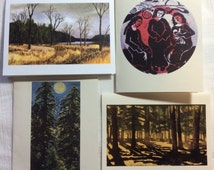

Hiroki is one of the founders and the volunteer Artistic Advisor of Donkey Mill Art Center, the home of Holualoa Foundation for Arts & Culture. He has traveled to Japan for an intensive artist-in-residence program sponsored by the Mokuhanga Innovation Laboratory and attended the 2nd International Mokuhanga Conference 2014 and Satellite Program in Tokyo. Over the course of his 40+ year career, he has worked in a variety of media and received numerous awards for outstanding work in his field. Bio: A native of Hawaii, Hiroki Morinoue received his BFA from California College of Art with high honors in 1973 and studied Sumi-e Painting and Mokuhanga Printmaking in early 1980s. Learn to read into an ink blob and discover an image through mystery and chance. Rather than covering it up, take advantage of watermarks, drips and stains.
#MOKU HANGA WATERCOLOR PAINTS HOW TO#
Both have very helpful staff and can answer any of your questions.Instructor: Hiroki Morinoue Schedule: Saturday and Sunday, February 12 - 13, 2022 from 10:00 AM - 4:00 PM # of Sessions: 2 sessions Location: Main Space & Print Studio Level/Prerequisite: Beginners Tuition/Admission: $185 Member / $230 Non-Member Supply Fee: $79.00 Supply fee includes a 2” Flat brush, Daniel Smith Watercolor Essentials Set: Thalo Crimson, Thalo Blue, Yellow Light / Lemon Yellow, Cadmium medium red, Ultramarine Blue, Cadmium Medium Yellow and Arches 140 lb paper - cold press and rough, 22” x 30” Class Description: In this workshop, students will explore the illustrative qualities of watercolor painting by learning how to interpret what might be understood as a ‘flaw’. Two other sources for Japanese paper are Awagami Factory and McClain’s Printmaking Supplies. Many of the prints look like watercolor painting, with great delicacy in line and variation in shading. As it’s a heavy paper, it suits my style, but I’m always on the search. A Modern Guide to the Ancient Art of mokuhanga. The fibers are long and very strong resulting in a paper that can be so thin it’s nearly see-through or very thick and heavy. It is made from the inner bark of the Mulberry tree and referred to as kozo.

It’s really quite remarkable and well worth watching a YouTube video on.

The paper is well suited to withstand the many stresses of hand printing, drying out and re-wetting. For the most part, it’s handmade and lovely. Japanese paper, known as washi, is unique. I have found the Surikomi Bake brushes to be very good, and I purchase them from McClain’s Printmaking Supplies. Most print artists use the traditional Hanga Bake brushes, but I’ll save that for another post as there is a lot to say. In all of my work, I use the Surikomi Bake brushes which are also used for stenciling. There are many kinds of brushes each with a purpose. Whereas the Western technique requires a roller or brayer. One of the greatest differences between Eastern and Western woodblock printmaking is how the ink or watercolor is applied to the blocks. Photo from McClain’s Printmaking Supplies Brushes However, now I use Futatsu Wari tools that I purchased from McClain’s Printmaking Supplies and I have no regrets. I believe the name of the boxed set was Power Grip. When I first started carving, I used a set of Japanese detail carving tools from Lee Valley. However, there are a lot of manufacturers of woodcutting tools, so some research and testing is a good idea before making any purchase. Japan has an outstanding reputation in bladesmithing and there are many levels of tools you can choose from. The cutting tools are important and I have invested in traditional woodcut tools from Japan. I purchase my shina from McClain’s Printmaking Supplies. It is soft and easy to carve but holds a sharp edge throughout multiple printings. It is a sustainable product grown in Japan and has a fine grain. However, unlike Shina, the surface isn’t finely sanded and has a texture. It carves easily and performs similarly to Shina. However, as old forests were farmed to near extinction other woods emerged as good choices. Cherry was always used in Japan because of its superior hard surface. Interestingly, there are not many woods suitable for this art form. In this post, I will give a brief overview of the most basic materials. It is a craft that requires great discipline and education, and its tools and materials are a good place to start in understanding the art form.

See more ideas about woodcut, woodblock print, japanese woodblock printing. All the supplies used are made by hand and have a long history. Explore Martha Knoxs board 'Moku-Hanga', followed by 101 people on Pinterest. A large part of the appeal of moku hanga, or Japanese woodblock printing, is rooted in its tools and materials.


 0 kommentar(er)
0 kommentar(er)
